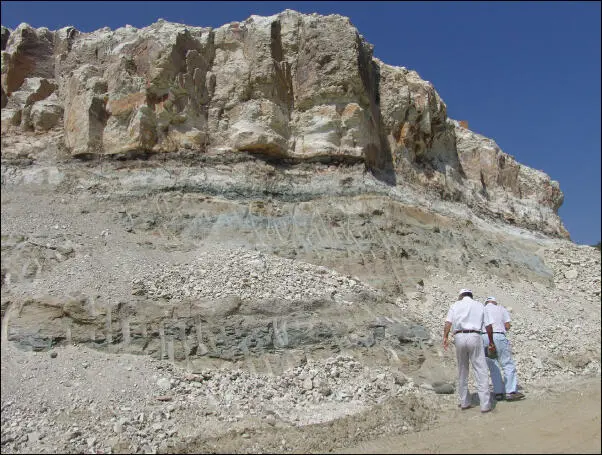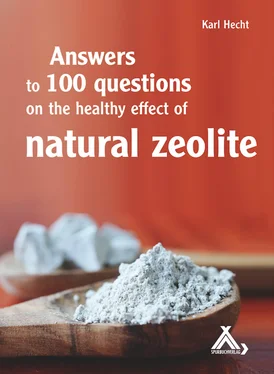•When I worked on research projects about the effects of psycho-pharmaceutical agents as a young doctor I realised that sooner or later I would come into conflict with the Hippocratic claim “Primum non nocere” (in English: do not harm as a doctor) by applying “chemicals” on sick people and accepting their side effects. This has motivated me to look for gentle natural remedies.
•Various research projects in the field of space medicine have made me aware of the significance of minerals for the fitness of human beings. I realised: minerals should be part of any therapy model. There is no life process without minerals. Minerals are the battery of human beings.
•Getting familiar with the outstanding research results of the American silicon expert Edith Muriel Carlisle and the Russian silicon expert H. G. Voronkov and his research team on the significance of silicon dioxide for the health of human beings.
•The successful application of zeolite and montmorillonite after the disastrous nuclear meltdown in Chernobyl (Ukraine). After the nuclear disaster in Chernobyl in 1986 500,000 tons of zeolite (which corresponds to a full freight train with a length of 124 km) were applied with the intention to decontaminate the released radionuclides. In addition, all people affected by the radiation disaster were also treated with zeolites, the sooner the treatment started, the better for the people. From that time on, I have been interested in zeolites and other aluminium silicates.
2_What are silicates?
First of all, silicates are very stable silicon-oxygen compounds that contain other very stable elements such as aluminium (which is the third most frequent element on our planet), magnesium, iron, sodium etc. The simplest silicate is silicon dioxide (SiO2). SiO2, which is also called silicic acid, has already been used very effectively in the human body. Other silicates that are important for human beings are natural zeolite and montmorillonite, also known under the terms bentonite and smectite. Owing to my experiences with their application as a preventive and therapeutic remedy I would like to compare their interaction to that of fraternal twins. When combined, they have a wide range of effects in the human body, whereas each twin contributes to the overall effect with a shared and individual characteristic.
However, there are more silicates than those that have been mentioned so far. More than 40 aluminium silicates are part of the very fertile soil of the earth’s crust: clays, loam and loess.
3_What is natural clinoptilolite-zeolite?
Natural zeolites are natural microporous rocks of volcanic origin that can be found in certain mountains in many countries. Altogether, there are more than 100 different types of zeolites. The clinoptilolite-zeolite, hereafter referred to as natural zeolite, which is chiefly used for health-improving and medical reasons, belongs to the so-called crystalline forms. The basic skeleton of the clinoptilolite-zeolite is a crystal lattice with calibrated hollow spaces of about 4.0-7.2 Ångström (1 Ångström = 0.1 nm). The crystal lattice (part with the anions) consists of silicon (SiO4) and aluminium (AlO4) tetrahedrons. These solid SiO4-AlO4 crystal lattices that have a netlike shape consist of cations such as calcium, magnesium, sodium, potassium etc. and crystal water (not unbound H2O). So far, at least 34 minerals have been detected in natural zeolites (clinoptilolite-zeolites), however, often in traces, which is exactly what a highly developed living organism needs.
4_What is montmorillonite/bentonite?
Bentonites are a white or grey white type of clay that is rich in minerals. The term derives from the place where they were discovered: Fort Benton, Montana, USA. Bentonites are so-called “sheet silicates” that originate from volcanic tuff containing silicon as a result of “weathering” and the impact of gravel bacteria, lichen and fungi, with montmorillonite as a main component. Montmorillonites were called after the place where they were supposedly discovered, the town Montmorillon (Vienne) in France. Pure montmorillonite has a grey white colour and is also characterised as a sheet silicate, just like bentonite, with anions from SiO4 and aluminium (AlO4) tetrahedrons. The ratio of silicon to aluminium in natural zeolites and montmorillonites is usually 3:1 to 8:1.
Montmorillonite, which originates from volcanic tuff, has outstanding effects for humans and animals.
5_What is the difference between bentonites and montmorillonites?
Normally, bentonites and montmorillonites (also called smectites) occur as a mixture of both silicates, however, at different percentages. There is a general international agreement on the terminology, i.e. all types of sheet clay with < 50 % montmorillonite have to be called bentonite. If the percentage of montmorillonite is > 50 % the term montmorillonite has to be used instead. A high percentage of montmorillonite is better for medical reasons because of its healing effect. The bentonite from Kazakhstan, which is certified in Germany and Russia, has a percentage of 95 % montmorillonite. For this reason, it has to be called montmorillonite. In order to test the quality of montmorillonite, montmorillonite powder has to be put into a glass of water. The quality is good when the powder starts to clump and is difficult to dissolve. Afterwards, the liquid has to be steered until the powder has dissolved. Now the liquid is ready to be drunk. As already mentioned, smectite is another term for montmorillonite.
6_How does the rough-structured zeolite become a consumption-friendly powder?
It takes three steps to produce a consumption-friendly powder. First of all, the zeolite rock is cut into smaller pieces and freed from foreign substances. Secondly, the natural zeolite is pulverized by means of micronization processes. Scientific examinations [Montinaro et al. 2013] and practical experiences with PMA zeolite show that an average grain size of approximately 7 µm is most effective in the human body. Thirdly, each charge is analysed and equipped with a data sheet. The data sheet reveals, among other things, the mineral and chemical composition, and confirms the absence of toxic substances and germs.
A zeolite grain consists of many tiny crystal lattice channels with a size of 0.4-0.72 nanometres. It looks like a sponge and can absorb ions like a sponge. The tiny channels are strictly calibrated and play an important role in the selective ion exchange. The selective ion exchange is not only important for the vital functions in the human body but also very interesting for technology. The production of synthesised zeolites according to the model of natural zeolites for a technical selective ion exchange has already become commonplace nowadays, the synthetically produced zeolites, however, are not suitable for human beings and should therefore not be applied here. (See question 87, p. 84 “Are synthetically produced zeolites interesting for health and medicine?”).
The following picture shows a typical zeolite mine (Gördes, Western Turkey).

Natural clinoptilolite-zeolite grains with a diameter of approx. 10 m in 300-fold magnification [modified according to Pavelie et al. 2004]
7_Scientists, doctors and the media claim that aluminium silicates are toxic and cause Alzheimer’s disease?
These claims are based on the views of so-called fringe scientists who only deal with a certain aspect of a topic, while ignoring the big picture and the complex interrelations. As a consequence, they come up with wrong conclusions that sooner or later turn out to be wrong. My experiences with it are that the vast majority of people prefers to believe in such wrong ideas rather than the truth, and that such ideas persist for years despite all evidence that proves that they are wrong. The same applies to the hypothesis about the relation between aluminium and Alzheimer’s disease.
Читать дальше













